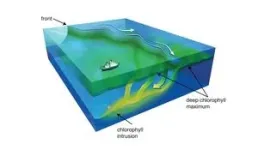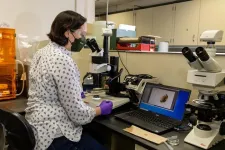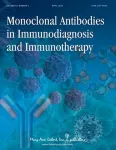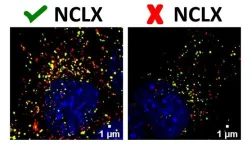(Press-News.org) PROVIDENCE, R.I. [Brown University] — Some of the ocean’s tiniest organisms get swept into underwater currents that act as a conduit that shuttles them from the sunny surface to deeper, darker depths where they play a huge role in affecting the ocean’s chemistry and ecosystem, according to new research.
Published in the Proceedings of the National Academy of Sciences and based on fieldwork during three research cruises spanning 2017 to 2019, the study focuses on subtropical regions in the Mediterranean Sea. It uncovered how some microscopic single-celled organisms that are too light to sink beyond 100 meters or so — like phytoplankton and bacteria — end up going deeper into the ocean where there's not enough sunlight for these photosynthetic organisms to grow, live and eat.
“We found that because these organisms are so small, they can be swept up by ocean currents that then bring them deeper than where they grow,” said Mara Freilich, an assistant professor in Brown University’s Division of Applied Mathematics and Department of Earth, Environmental and Planetary Sciences who launched the work as a Ph.D. student a joint program at MIT and the Woods Hole Oceanographic Institution. “It's often a one-way trip for these organisms, but by taking this trip, they play a critical role in connecting different parts of the ocean.”
Freilich conducted the research during her Ph.D. with Amala Mahadevan, senior scientist at Woods Hole, in a close collaboration with senior scientist at the Marine Biological Laboratory Alexandra Z. Worden and her team.
The currents the team found are called intrusions and by sweeping up the tiny organisms, they help change the types of food available in the deeper layers of the ocean while also transporting a significant amount of carbon from the water surface. This helps feed other organisms in the ocean’s food chain and increases the complexity of the ecosystem at deeper depths, influencing how life and chemistry work underwater.
Altogether, the study challenges conventional understanding of how carbon, which is turned into organic matter by photosynthesis in the sunlit layer of the ocean, gets transported to depth.
“The majority of photosynthesis — by which light is converted into organic carbon, a food source for living organisms — happens in the upper 50 meters of the ocean, so the question has always been: How does the carbon that gets fixed through photosynthesis get into the deep ocean?” Freilich said. “The sinking of carbon-rich particles has always been thought to be the only answer to this question. But what we found is that tiny, single-celled organisms get caught in the oceanic flow to form intrusions… Such intrusions are significant features of the subtropical ocean — while they extend tens of kilometers laterally, they also descend hundreds of meters in the vertical, bringing cells and carbon with them. This mechanism has been unaccounted in previous estimates of carbon transport.”
The researchers found the intrusions occur year-round and originate in areas rich with biomass, including where the plant-like organisms are at their highest concentrations. Previously, ocean currents were only thought to carry carbon to depth seasonally. The researchers suggest these intrusions are widespread in the world’s subtropical oceans. They provide conduits for the continual transport of carbon and oxgyen from the sunlit ocean to depth.
“We observed microbial communities that looked just like surface microbial communities down to 200 meters,” Freilich said. “In other regions, we think this could be a lot deeper. To our surprise we found that the majority of microbes in the intrusions were bacteria that feed on carbon fixed by the photosynthesizing cells. This showed that the bulk of the biomass transported from the sunlit layers comprised of non-photosynthetic microbes.”
As a collaboration between the US, Spain and Italy, the scientists went on three trips to the subtropical Mediterranean ocean for the study. They used special tools to measure properties like water temperature, salinity and the abundance of the tiny organisms at different depths. The analyses, conducted in collaboration with microbial ecologist, Alexandra Worden at the Marine Biological Laboratory, helped show the differences between intrusion samples and background waters. Seeing that the microbial communities in the deeper intrusion samples resembled surface microbial communities showed that they were being transported to depth. The researchers also used computer models to simulate ocean currents to reveal how the communities of tiny plants and bacteria moved in the water.
“With the strong data from the Mediterranean establishing this process of three-dimensional conduits as a mechanism for bringing surface microbes to the dark ocean in warm waters, we have been able to see traces of similar export in major open ocean regions,” said Worden.
Along with underscoring the ecological importance of intrusions in shaping oceanic biodiversity, the study also touches on how intrusions could be affected by climate change. It is thought that as the Earth's oceans get warmer, the proportion of carbon in tiny cells would increase and the transport in intrusions may not be as affected as other mechanisms that carry carbon to depth. Intrusions change our understanding of how carbon moves around in the ocean and could help regulate carbon storage and microbial dynamics in the deep ocean.
“There's so much more to explore now that we've found this,” Freilich said. “What's next is taking what we've learned here and determining if we can use this to predict how changes in the microbial community composition would affect the transport of carbon and the global carbon cycle in a changing climate.”
END
For microscopic organisms, ocean currents act as 'expressway' to deeper depths, study finds
New research shows how tiny plant-like organisms hitch a ride on ocean currents to reach darker and deeper depths, where they impact carbon cycling and microbial dynamics in the subtropical oceans
2024-05-02
ELSE PRESS RELEASES FROM THIS DATE:
Rice’s Harvey, Ramesh named to National Academy of Sciences
2024-05-02
HOUSTON – (May 2, 2024) – Rice University’s Ramamoorthy Ramesh and Frank Reese Harvey are among 120 new U.S. members elected to the National Academy of Sciences (NAS) “in recognition of their distinguished and continuing achievements in original research,” according to a statement from the organization.
Members are elected by their peers based on their contribution to one of six areas of scientific inquiry following an extensive vetting process. Established in 1863 through an act of Congress, NAS serves as a source of independent, objective advice on science ...
Oil palm plantations are driving massive downstream impact to watershed
2024-05-02
AMHERST, Mass. – The global demand for palm oil—the most widely consumed vegetable oil on the planet, in everything from instant noodles to lipstick—is driving worldwide tropical deforestation. While many studies have shown the loss of biodiversity when rainforests are converted to oil palm plantations, researchers at the University of Massachusetts of Amherst are the first to show far-reaching and wide-ranging disturbances to the watersheds in which such plantations occur. Because many Indigenous peoples rely on water downstream from the plantations for their daily needs, the marked decrease in water quality has ...
Nanotubes, nanoparticles, and antibodies detect tiny amounts of fentanyl
2024-05-02
A research team at Pitt led by Alexander Star, a chemistry professor in the Kenneth P. Dietrich School of Arts and Sciences, has developed a fentanyl sensor that is six orders of magnitude more sensitive than any electrochemical sensor for the drug reported in the past five years. The portable sensor can also tell the difference between fentanyl and other opioids.
Their work was published in the journal Small.
Fentanyl is a synthetic opioid and one of the main drivers in overdose deaths in the United States, Star said. It’s often mixed with other drugs, but because ...
New eco-friendly lubricant additives protect turbine equipment, waterways
2024-05-02
Scientists at the Department of Energy’s Oak Ridge National Laboratory have developed lubricant additives that protect both water turbine equipment and the surrounding environment.
Each year, roughly 2.47 billion gallons of lubricating oil are consumed in the United States alone for engines and industrial machinery, according to DOE, with about half eventually finding its way into the environment.
While environmentally acceptable lubricants are available, they are not optimized with additives that can greatly improve performance while posing minimal environmental impact if accidentally released. To create nontoxic, biodegradable and high-performing lubricant ...
Monoclonal Antibodies in Immunodiagnosis and Immunotherapy appoints new Deputy Editor-in-Chief, Andrei Moroz, PhD
2024-05-02
Mary Ann Liebert, Inc., is pleased that Andrei Moroz, PhD, has been appointed the new Deputy Editor-in-Chief of the bimonthly journal Monoclonal Antibodies in Immunodiagnosis and Immunotherapy. Dr. Moroz is joining Cory Brooks, PhD, as part of the senior editorial leadership team for the journal.
Monoclonal Antibodies in Immunodiagnosis and Immunotherapy is a peer-reviewed venue for promoting and sharing research rooted in hybridoma technology. It aims at advancing the understanding of the biology and immunology that underscores the utility of antibodies as diagnostics and therapeutics. The journal publishes ...
Optical pumped magnetometer magnetocardiography as a potential method of therapy monitoring in fulminant myocarditis
2024-05-02
https://www.scienceopen.com/hosted-document?doi=10.15212/CVIA.2024.0031
Announcing a new article publication for Cardiovascular Innovations and Applications journal. Fulminant myocarditis (FM) is associated with high mortality and an unfavorable long-term prognosis. However, noninvasive, rapid diagnostic and monitoring methods for FM are lacking.
This article details the case of a patient diagnosed with FM through a comprehensive assessment involving typical clinical symptoms, laboratory analyses, echocardiographic evidence, and cardiac magnetic resonance (CMR) findings. Before the patient underwent CMR, optical pumped magnetometer magnetocardiography (OPM-MCG) revealed abnormalities characteristic ...
Heart failure registries in Asia – what have we learned?
2024-05-02
https://www.scienceopen.com/hosted-document?doi=10.15212/CVIA.2024.0026
Announcing a new article publication for Cardiovascular Innovations and Applications journal. Heart Failure (HF) is one of the leading problems in cardiology practice today. Acute decompensated heart failure (ADHF) is a significant cause of mortality and morbidity worldwide, and this is more relevant in the Asian subcontinent with a high population burden. Various regional registries in Asia have given us valuable insight into the aetiology and outcomes in this context. Though there are regional differences, it is clear from the review carried out in this paper that HF affects a much younger population. ...
Study helps understand how energy metabolism is regulated at cellular level
2024-05-02
An article published in The Faseb Journal describes a Brazilian study analyzing the correlation between two key energy metabolism regulation processes: the absorption and release of calcium ions by mitochondria, the organelles that generate energy for cells; and autophagy induced by calorie restriction. Autophagy occurs when cells break down and reuse their own cytoplasm.
The study was conducted at the Center for Research on Redox Processes in Biomedicine (Redoxome), a Research, Innovation and Dissemination Center (RIDC) funded by FAPESP and hosted by the University of São Paulo’s Institute of Chemistry ...
Stay active – or get active – to boost quality of life while aging, study suggests to middle-aged women
2024-05-02
Consistent adherence to physical activity guidelines throughout middle-age is associated with a higher health-related quality of life in women, according to a new study publishing May 2nd in the open-access journal PLOS Medicine by Binh Nguyen of University of Sydney, Australia, and colleagues.
The evidence for an association between physical activity and health-related quality of life has been based primarily on cross-sectional studies and short-term randomized controlled trials. Few longitudinal studies have measured physical activity at more than one time point and examined the long-term causal effects ...
*FREE* Friendship-nomination approach identifies key villagers to diffuse health messages
2024-05-02
In experiments in isolated villages in Honduras, researchers evaluated a new strategy for identifying individuals that could be targeted for effective information spreading. Their approach – more effective than random targeting, and also less time-requisite than approaches that require a complete understanding of the relevant social network – could have far-reaching policy implications in lower and middle-income countries. Understanding the structure and function of human social networks has yielded insights for exploiting social ...
LAST 30 PRESS RELEASES:
Reviving dormant immunity: Millimeter waves reprogram the immunosuppressive microenvironment to potentiate immunotherapy without obvious side effects
Safety decision-making for autonomous vehicles integrating passenger physiological states by fNIRS
Fires could emit more air pollution than previously estimated
A new way to map how cells choose their fate
Numbers in our sights affect how we perceive space
SIMJ announces global collaborative book project in commemoration of its 75th anniversary
Air pollution exposure and birth weight
Obstructive sleep apnea risk and mental health conditions among older adults
How talking slows eye movements behind the wheel
The Ceramic Society of Japan’s Oxoate Ceramics Research Association launches new international book project
Heart-brain connection: international study reveals the role of the vagus nerve in keeping the heart young
Researchers identify Rb1 as a predictive biomarker for a new therapeutic strategy in some breast cancers
Survey reveals ethical gaps slowing AI adoption in pediatric surgery
Stimulant ADHD medications work differently than thought
AI overestimates how smart people are, according to HSE economists
HSE researchers create genome-wide map of quadruplexes
Scientists boost cell "powerhouses" to burn more calories
Automatic label checking: The missing step in making reliable medical AI
Low daily alcohol intake linked to 50% heightened mouth cancer risk in India
American Meteorological Society announces Rick Spinrad as 2026 President-Elect
Biomass-based carbon capture spotlighted in newly released global climate webinar recording
Illuminating invisible nano pollutants: advanced bioimaging tracks the full journey of emerging nanoscale contaminants in living systems
How does age affect recovery from spinal cord injury?
Novel AI tool offers prognosis for patients with head and neck cancer
Fathers’ microplastic exposure tied to their children’s metabolic problems
Research validates laboratory model for studying high-grade serous ovarian cancer
SIR 2026 delivers transformative breakthroughs in minimally invasive medicine to improve patient care
Stem Cell Reports most downloaded papers of 2025 highlight the breadth and impact of stem cell research
Oxford-led study estimates NHS spends around 3% of its primary and secondary care budget on the health impacts of heat and cold in England
A researcher’s long quest leads to a smart composite breakthrough
[Press-News.org] For microscopic organisms, ocean currents act as 'expressway' to deeper depths, study findsNew research shows how tiny plant-like organisms hitch a ride on ocean currents to reach darker and deeper depths, where they impact carbon cycling and microbial dynamics in the subtropical oceans








